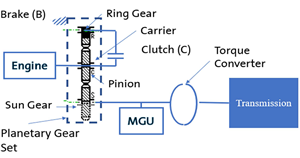A Novel Engine Start Mechanism for an Electrified Powertrain
DOI:
https://doi.org/10.46604/ijeti.2022.9118Keywords:
P2 hybrid, tip-in, flying start, planetary starterAbstract
This study aims to evaluate a novel starting mechanism (planetary starter) to crank the engine of a hybrid electric vehicle for a flying start maneuver. The study describes the P2 architecture and the planetary starter mechanism. The disturbance during engine crank and driveline engagement is a vital drive quality metric for a P2 vehicle. A linear quadratic Gaussian (LQG) controller is developed to reject the disturbance. The main results of the vehicle acceleration (disturbance) with and without the controller are compared. The results indicate that the planetary starter can crank the engine, and the closed-loop controller can effectively reject the active disturbances during the engine crank event.
References
N. Shidore, et al., “Fuel Economy and Drivability Trade-Off for Mild Hybrid Electric Vehicle Architectures,” Industrial Problems on Machines and Mechanisms (IPRoMM), pp. 709-719, December 2020.
L. Hao, et al., “Brushless Fast Starter for Automotive Engine Start/Stop Application,” IEEE Transactions on Industry Applications, vol. 56, no. 6, pp. 6041-6052, November-December 2020.
W. Cai, “Comparison and Review of Electric Machines for Integrated Starter Alternator Applications,” Conference Record of the IEEE Industry Applications Conference, pp. 386-393, October 2004.
M. Raghavan, et al., “The Kinematics and Dynamics of Engine Start Systems,” Asian Mechanism and Machine Science (Asian MMS), pp. 293-302, December 2018.
G. Fulks, et al., “High Performance Stop-Start System with 14 Volt Belt Alternator Starter,” SAE International Journal of Engines, vol. 5, no. 3, pp. 864-873, August 2012.
B. K. Ganesan, et al., “Enhancement of Starter Brush Life for Micro Hybrid (Start/Stop) Applications,” International Conference on Advances in Design, Materials, Manufacturing, and Surface Engineering for Mobility, Article no. 2018-28-0102, July 2018.
D. H. Myszka, et al., “Development of a Spring-Based Automotive Starter,” SAE International Journal of Commercial Vehicles, vol. 7, no. 1, pp. 286-294, April 2014.
L. Hao, et al., “Enhancing Engine Starting Performance Using High-Power Density Brushless Starter,” WCX SAE World Congress Experience, Article no. 2020-01-0459, April 2020.
M. Raghavan, “Optimizing Engine Start Systems with Application to Sailing/Coasting and Mild Hybridization,” Advances in Technology Innovation, vol. 5, no. 1, pp. 1-9, January 2020.
B. Wang, et al., “Design Optimization of Modular Permanent Magnet Machine with Triple Three-Phase for Aircraft Starter Generator,” AeroTech Conference, Article no. 2022-01-0055, March 2022.
J. Gibbs, et al., “On Board Jump Start for Belted Alternator Starter Hybrids,” SAE World Congress and Exhibition, Article no. 2011-01-0867, April 2011.
J. Kelly, et al., “Specification and Design of a Switched Reluctance 48V Belt Integrated Starter Generator (B-ISG) for Mild Hybrid Passenger Car Applications,” SAE World Congress and Exhibition, Article no. 2014-01-1890, April 2014.
L. Du, et al., “Optimal Speed Profile for Minimum Vibration during Engine Start Using Pontryagin’s Minimum Principle Approach,” New Energy and Intelligent Connected Vehicle Technology Conference, Article no. 2019-01-5026, November 2019.
M. Raghavan, “Long Pinions for Alternative Transmission Mechanizations,” Proceedings of Engineering and Technology Innovation, vol. 9, pp. 32-37, July 2018.
J. B. Burl, Linear Optimal Control, H2 and H-Infinity Methods, Addison Wesley Publications, 1998.
L. A. Sievers, et al., “Comparison of Two LQG-Based Methods for Disturbance Rejection,” Proceedings of the IEEE Conference on Decision and Control, pp. 483-485, December 1989.

Published
How to Cite
Issue
Section
License
Copyright Notice
Submission of a manuscript implies: that the work described has not been published before that it is not under consideration for publication elsewhere; that if and when the manuscript is accepted for publication. Authors can retain copyright in their articles with no restrictions. Also, author can post the final, peer-reviewed manuscript version (postprint) to any repository or website.

Since Jan. 01, 2019, IJETI will publish new articles with Creative Commons Attribution Non-Commercial License, under Creative Commons Attribution Non-Commercial 4.0 International (CC BY-NC 4.0) License.
The Creative Commons Attribution Non-Commercial (CC-BY-NC) License permits use, distribution and reproduction in any medium, provided the original work is properly cited and is not used for commercial purposes.







.jpg)


